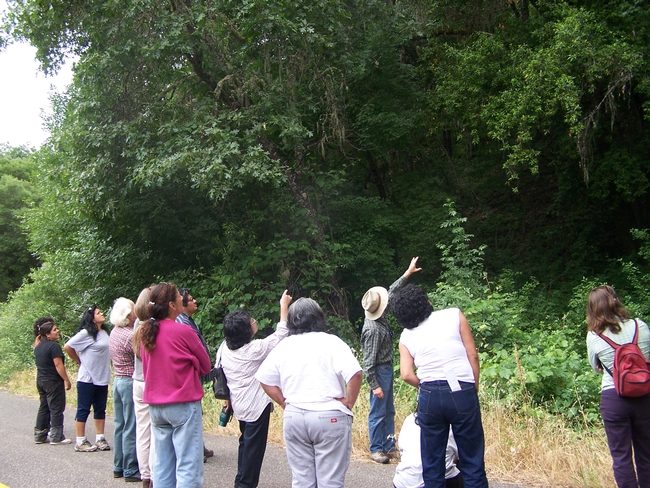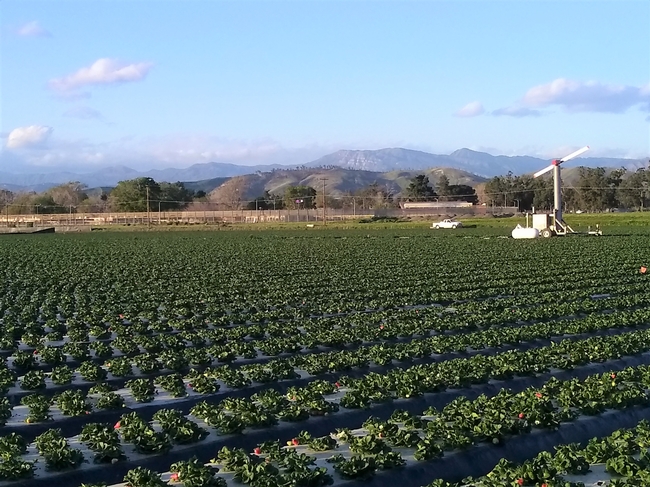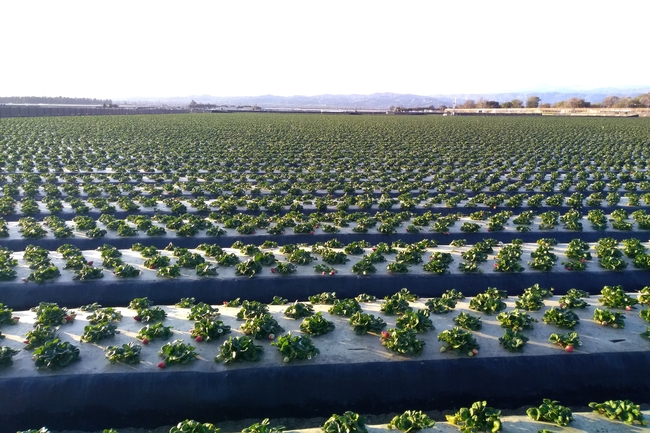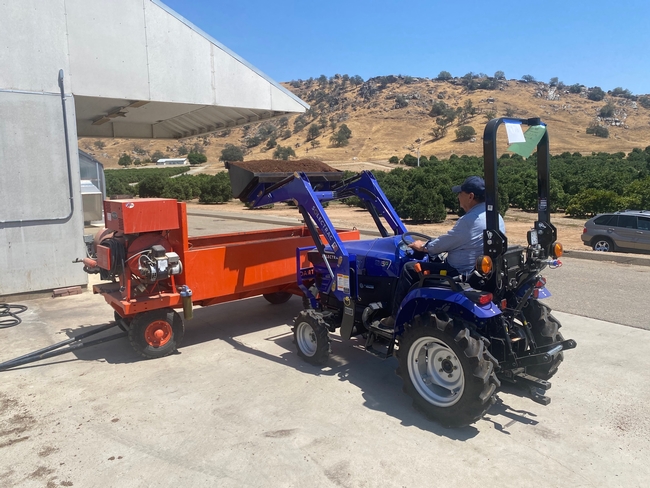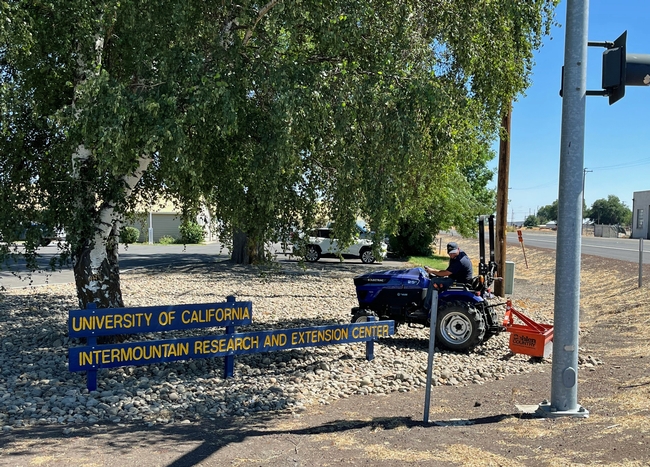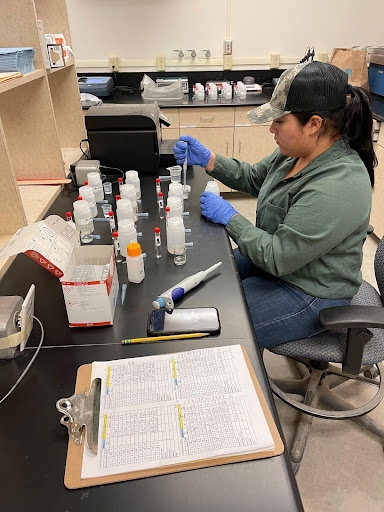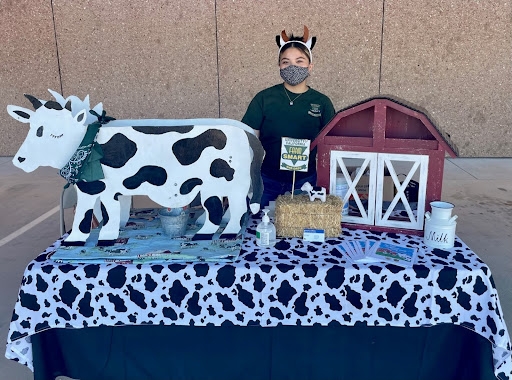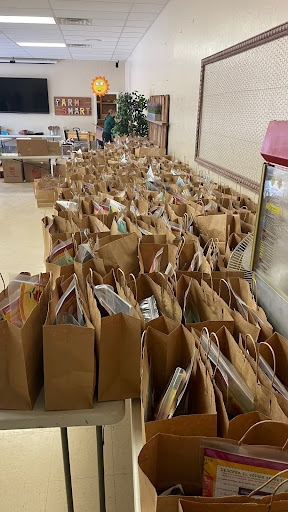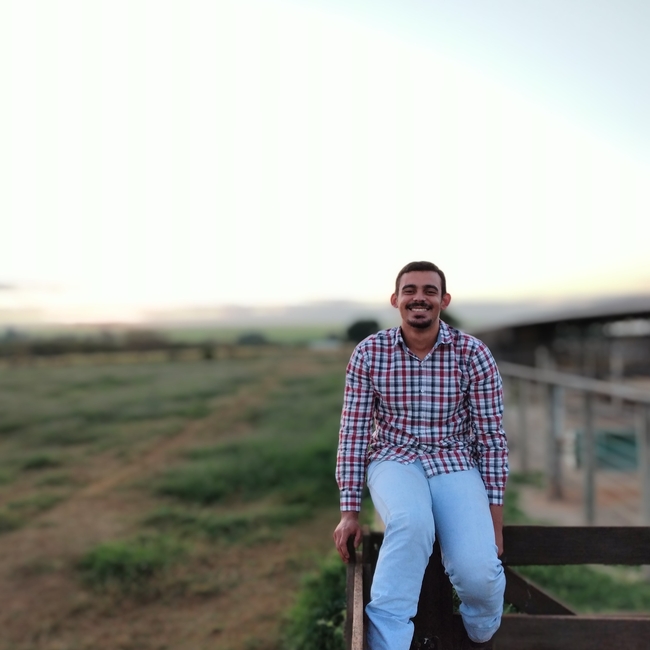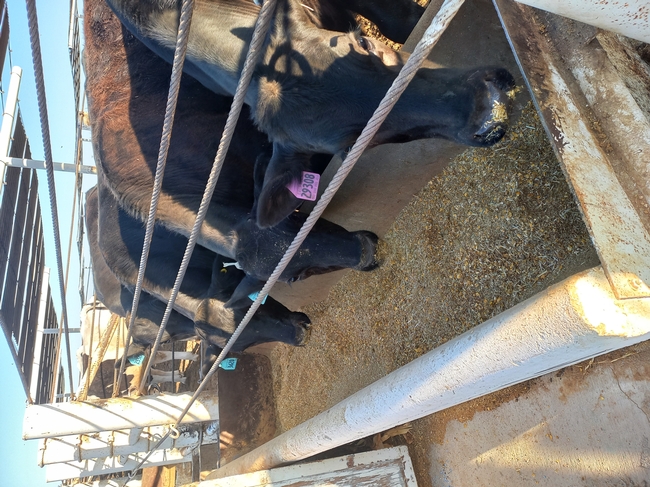
Posts Tagged: Research and Extension
Postharvest Center: New research focus and outreach
Still providing the world with top-notch information
UC Davis has been a leading source of information for people handling, packaging and transporting crops since the beginnings of the Postharvest Research and Extension Center in 1979. Now, the center is strengthening its focus on the needs of industry, offering fresh courses, weaving strategic partnerships and expanding into digital media, all while building up its research capacity to better serve the needs of the produce industry.
“We're asking people in the industry, ‘How can we support you? How can we better listen to you?' We want people to know we're not disconnected know-it-alls,” said new center co-director Bárbara Blanco-Ulate, an associate professor in the UC Davis Department of Plant Sciences. “We're getting more faculty involvement, people with expertise in related fields such as quality engineering and safety, as well as bringing in emeriti faculty and people from around California. We're forming partnerships with organizations around the world, and we've opened up to people from other institutions around the country.”
“The larger the network, the more things we can do,” added fellow co-director Irwin R. Donis-Gonzalez, an associate professor of UC Cooperative Extension in the Department of Biological and Agricultural Engineering.
The foundation: Expanded research
The new co-directors will beef up the center's applied science component with the hiring of a research specialist. They aim to provide new information that can be used industry-wide as companies explore new ways to handle and store fresh produce.
“We're building the capacity to respond to industry requests for research,” Blanco-Ulate said.
New courses, national reach
Their first workshop, held recently, demonstrates the center's renewed vision and commitment to broad networking: The Agricultural Water Systems Workshop addressed current concerns around water management and risks to food safety. Partners in the course included the Western Growers Association, the University of Arizona, the University of Florida and Salinas-based Taylor Fresh Foods, Inc.
Courses given over the past several years that have been recorded will be posted to the center's new, online video library and to the center's YouTube channel.
“People can watch those courses for free,” Blanco-Ulate said. In addition, new courses will be offered in-person and hybrid.
The co-directors are working with the University of California to offer continuing and professional education credits to course participants.
Online resources – many for free!
The center's website features a database with scores of free product fact sheets, which are downloaded by users around the world. The fact sheets are so highly regarded that they are considered expert evidence in legal proceedings, Blanco-Ulate said. Visitors to the website can also find links to research papers published by UC Davis faculty, including seminal works by Adel Kader, who founded the center.
Books are offered through the center's online bookstore and include titles through UC Agriculture and Natural Resources. Ten new titles are being planned, including topic-specific updates taken from previous classics.
Debunking myths: Ethylene
A new newsletter deals with a new problem: Misinformation about food and food handling that spreads through social media. One example is the use of ethylene to ripen produce such as bananas, so that they can be safely stored until ready for the consumer.
“Ethylene is safe for humans and does not leave any harmful residue on produce,” Donis-Gonzalez wrote in the center's latest newsletter. Even better news, he added: The levels of ethylene used on food are a tiny fraction of the concentrations that would be needed to create an explosion, one of the false alarms being raised in social media.
Evolving with the times
After 47 years of service, these and more updates will keep the center at the forefront of an evolving postharvest world. The top goal: Meet the needs of agriculturalists, industry and consumers.
“We are adapting to new needs, with both the resources and the workshop we're offering,” Donis-Gonzalez said.
“As a land-grant institution, we take our outreach mission seriously,” Blanco-Ulate added.
Related links
More about the UC Davis Postharvest Research and Extension Center.
This story first appeared on the UC Davis Department of Plant Sciences site.
Tribal Engagement at the Hopland Research and Extension Center
The Hopland Research and Extension Center is situated on the traditional, ancestral and unceded lands of the Shóqowa and Hopland People, whose historical and spiritual relationship with these lands continues to this day and beyond (for more on the Land and people history of the site, see this story map). It was, and continues to be, difficult for Indigenous people to thrive in the Shanél Valley after they were forced off the fertile land and had to resettle on relatively small upland parcels and away from freshwater sources. UC ANR staff and academics at the Hopland Research and Extension Center are working to build relationships with the Hopland Band of Pomo Indians who live and work next door at the Hopland and Nacomis Rancherias.
Hopland REC Director John Bailey is committed to building relationships with the intention of enabling maximum benefits for local tribal communities. Tribal Chairperson Sonny Elliot and the Council have been helping us find ways to collaborate after a long history of distrust and despite the University's founding using the sales of expropriated lands (Land-Grant College Act, 1862) and our continued occupation of California Indian territories. Bailey is working with local tribes to define a newly funded Academic Advisor position to build relationships, advance UC policy around working with Tribes, and restore good fire to the landscape with the help of cultural practitioners.
We have secured funding to hire a Native college student to help revitalize ecocultural wetlands in Hopland this summer. The intern will spend time talking with Indigenous people living within the oak woodland landscape or North Coast California and develop a plan for stewarding ecoculturally important sites at the Hopland Research and Extension Center with the Hopland Band of Pomo Indians and local experts in traditional ecological knowledge. This internship offers an opportunity for a Native American college student or two to learn about wetland systems and traditional ecological knowledge; and share their experience with other tribal community members.
Hunting opportunities for Tribal youth and their families and plant collection sites for basket materials are available. The hope is that more cultural ceremonies can take place where generations of Pomo people spent time near the waterways that span Hopland REC. Finally, together we are exploring ways to modify access of existing roads at Hopland REC to allow for potential emergency evacuation for Rancheria residents.
More to come, we hope.
Agricultural research and education center moving to new site in Ventura County
UC Hansen Research and Extension Center to expand capacity at Camarillo location
The University of California Hansen Agricultural Research and Extension Center – the site of popular school field trips, 4-H programs, a UC Master Gardener demonstration garden, and numerous research trials on crops and landscape plants – is moving to a new location on the west side of Camarillo. The center was established through an endowment bequeathed to the UC by Saticoy farmer Thelma Hansen, who sought to support university research and extension activities benefiting Ventura County.
For the past 25 years, Hansen REC has been located on the historic Faulkner Farm in Santa Paula. At 27 acres, Hansen REC was the smallest of the nine RECs across the state operated by UC Agriculture and Natural Resources; in 2019, UC ANR leadership decided a larger property was needed to expand the center's capacity. The Faulkner Farm was sold in March 2021, but a portion was leased back to the UC to sustain its programs until a new location was identified.
In December 2022, the UC acquired a 114-acre farm property in Camarillo to serve as Hansen REC's new home. Moving structures and equipment from Faulkner Farm will take place over the next six months. Public programs at the new location are on hold until seismic retrofitting and other building upgrades are completed. A new research and educational facility also will be built, with an estimated opening date in 2027 or 2028.
“Our planning committee looked for a site on the Oxnard Plain that is representative of the coastal agriculture environment and conducive to research on Ventura County's high-value crops, such as strawberries,” said Annemiek Schilder, Hansen REC director. “We also sought a location with diverse soil types, access to sufficient irrigation water, and a low risk of flooding – and we're pleased that this Camarillo property meets most of our search criteria.”
Of the approximately 104 cultivable acres, 28 are certified organic, which will allow researchers to study organic as well as conventional crop production methods, Schilder noted. She said another bonus of the new location is its proximity to California State University, Channel Islands and the Rodale Institute California Organic Center, which are both potential partners for future research and a student organic farm on site.
Initial plans for the new Hansen REC facility include offices, conference rooms, laboratories, greenhouses, a demonstration kitchen, and indoor and outdoor education areas. The center will aim to be water-efficient and energy-neutral, relying on solar panels for much of its energy usage. The UC Cooperative Extension Office in Ventura is also slated to move to the new facility.
“We fully expect Hansen REC to become a vibrant research and education hub that provides science-based solutions and is responsive to the needs of agricultural, rural and urban communities and the environment in Ventura County,” said Glenda Humiston, UC vice president for agriculture and natural resources. “We're excited to expand current programming while bringing in new educational opportunities, such as the UC Master Food Preserver and Master Beekeeper programs.”
Electric tractors reduce carbon emissions at UC ANR research and extension centers
Zero-emission tractors perform many tasks of diesel tractors, without noise or exhaust
The University of California, a national leader in sustainability, has pledged to become carbon neutral by 2025. To reduce its reliance on fossil fuels, UC Agriculture and Natural Resources has replaced several of its diesel-powered tractors with electric tractors at its research and extension centers.
Seven of the nine UC research and extension centers – Intermountain located in Siskiyou County, Hopland in Mendocino County, Kearney and West Side in Fresno County, Lindcove in Tulare County, Desert in Imperial County and Hansen in Ventura County – started using the Solectrac e25 in July. The researchers plan to share what they learn from using the electric tractors.
“Charging is easy, we are using a standard 110V connection, no charging station needed,” said John Bailey, director of the University of California Hopland Research and Extension Center. “For faster charging, you can use a 220V connection – again, no charging station needed, just a regular receptacle – but we haven't gone there yet.”
The electric tractor runs for about five hours, depending on the type of use and the speed, on a charge.
“We will use the electric tractor to mix the soil for planting trees in the greenhouse,” said Ashraf El-kereamy, director of UC Lindcove Research and Extension Center in Exeter, which focuses on citrus research. “Also, for pulling the trailer with the fruit bins during harvest, it will be good as it does not emit any gases.”
The electric tractor is being used to move materials in the loader at UC Hopland REC. “It has worked well for this, functioning similarly to a standard diesel tractor,” said Bailey.
“We have also used it to clean our sheep barn, scraping the pens to get ready for lambing season,” Bailey said. “This involves pushing or dragging straw bedding and manure. The tractor functions well in tight spaces due to its compact size.”
Bailey learned one downside is that the front end is a little too light, making it difficult to generate enough downward pressure with the loader to effectively scrape the floor without reducing the front wheel traction.
“We are planning to add some weight to the front, a standard practice with tractors to increase traction. The tractor has the mounting to enable this so it should not be a big deal,” Bailey said. “Our operators really appreciate the lack of noise and exhaust, especially when working in the barn or in tight spaces.”
The small electric tractor is also being used in tight places at the UC Intermountain Research and Extension Center in Tulelake.
“The tractor that we obtained from the company is too small for the majority of our farm needs,” said Rob Wilson, Intermountain REC director. “We purchased a small box scraper and rototiller for the tractor and we are using it around our facility grounds. We also use it out in the field in tight spaces that are too small for our larger tractors to operate.”
“The tractor is quiet, powerful for its size and operates very similar to the diesel-powered tractors with regard to the controls, hydraulics and three-point assembly. The tractor also has a lot of torque and speed.”
Annemiek Schilder, director of UC Hansen Agricultural REC, added, “I think another advantage is that the tractors can go very slowly, which is helpful for some uses such as harvesting.”
The researchers will continue to evaluate the electric tractors throughout the year.
“Our main usage will come in the spring, mowing around our headquarters and on roadsides,” Bailey said. “We are purchasing a 4-foot flail mower that can mount to the rear PTO, but won't really put it into use until April.” The power take-off, or PTO, is the shaft that transfers power from the tractor to the attachment.
Other benefits of electric tractors include no engine oil to change and no diesel fuel.
“If the farmer already has solar, they will see close to zero fuel charges,” Bailey added. “Even without solar, their fuel costs should be reduced depending on local electrical cost. Also, the engine only has one moving part compared to dozens in a diesel tractor so maintenance costs should be reduced significantly, something that is proving true in electric cars.”
The Solectrac e25 tractors each cost $27,999 and the optional loader was about $4,000.
The California Air Resources Board is offering incentives to buy zero-emission equipment through its Funding Agricultural Replacement Measures for Emission Reductions Program. FARMER provides funding through local air districts for agricultural harvesting equipment, heavy-duty trucks, agricultural pump engines, tractors and other equipment used in agricultural operations.
Desert Research and Extension Center hosts international agriculture student interns
Caring for feedlot cattle, examining onion irrigation practices, and teaching preschoolers about agriculture are not part of the typical college curriculum. But for Desert Research and Extension Center's five college student interns, these activities are what fill their days.
Located on 255 acres of Southern California desert, DREC focuses on advancing irrigated desert agriculture, livestock and feedlot management, and pest management. It is also home to the Farm Smart agricultural education program, reaching approximately 7,800 participants annually.
In February, DREC welcomed the college student interns - creative thinkers working at the intersection of experimental research and agriculture education. During the internship, the students are working on-site under the mentorship of academics and staff members on applied projects. After years of COVID restrictions, the center is excited to welcome the students in person for hands-on engagement with the research and the public.
"Hosting students at DREC helps us to fulfill our mission while training the next generation of professionals," says Jairo Diaz, Director of DREC. "I am particularly motivated to provide experiential learning activities to underrepresented groups in agriculture and STEM careers."
Read on to learn about each of these budding agronomists.
Dianely Alba
Dianely Alba is majoring in agronomy at the Universidad Autonoma de Baja California, Mexico (This university is about 20 miles south of DREC). She is working under the mentorship of Jairo Diaz-Ramirez on a project focused on improving irrigation and nutrient management practices in onion production in Imperial County.
Melina Munoz
Melina Munoz is a student at Imperial Valley College studying elementary education. She is an intern for DREC's Farm to Preschool Festival. Munoz is in charge of developing and translating activities, planning and implementing the festival, and data entry for participant registration and evaluation information.
Lester Nolasco
Lester Nolasco grew up on a farm in Honduras, so he has been involved with animals and agriculture from a young age. He is working under the mentorship of Pedro Carvalho, the Feedlot Management Specialist. Nolasco is currently working on feedlot cattle management and beef cattle nutrition.
“Although my passion is cattle, when you work with these animals, you indirectly learn about agriculture and crops in general because that is also an important part of cattle nutrition,”says Nolasco. Alongside the other feedlot management interns, Nolasco feeds animals, cleans pens, mixes feed, weighs cattle, and does lab work. “It is such a nice experience for me because I had only worked with dairy cattle in the past and this internship is teaching me a lot. I would like to learn as much as I can about beef cattle nutrition. Hopefully, in the future, I will be a professor and share the knowledge I have learned with other professionals back in my country.”
Heitor Otávio Martins de Oliveira
Heitor Otávio Martins de Oliveira has worked with animals throughout his life, starting with his parents' farm. He attended veterinary school, where he continued to learn about agriculture. At DREC, Otávio Martins de Oliveira is working on beef cattle nutrition management. In addition to daily maintenance tasks, he weighs the cattle monthly and provides any necessary treatments.
“I would like to get as much knowledge as I can about nutrition in the USA and then return to my home country of Brazil to work there,” says Otávio Martins de Oliveira. “Maybe I will get a master's degree related to reproduction in cattle.”
Willi Meireles
Willi Meireles was introduced to Carvalho by his professor in Brazil. He is working on evaluating the use of feed additives to increase the performance of feedlot cattle.
“My grandparents own a farm where beef cattle are raised, so since I was a child, I have worked with animals and always liked animal science,” reflects Meireles. “I intend to specialize in ruminant nutrition and, after working hard, be able to have my own beef cattle.”





